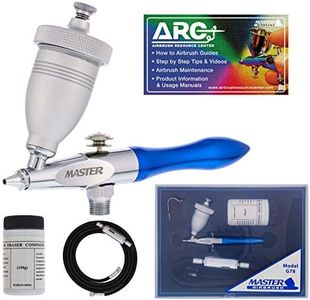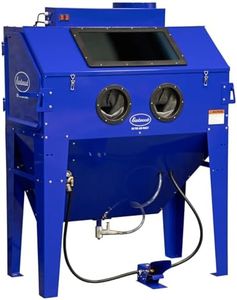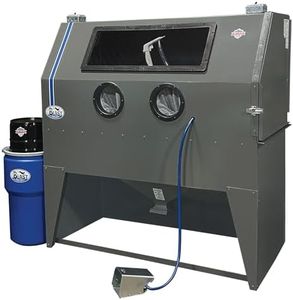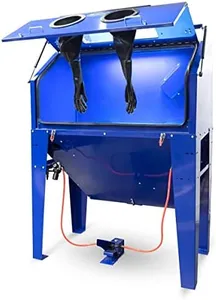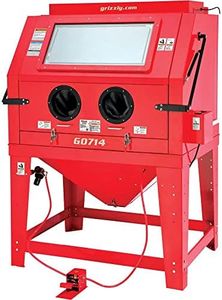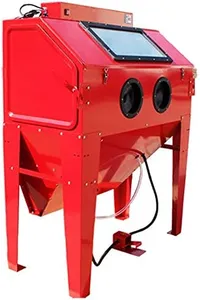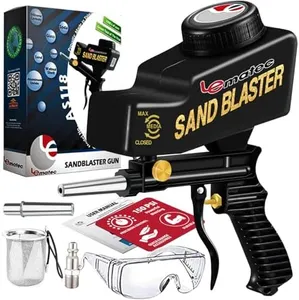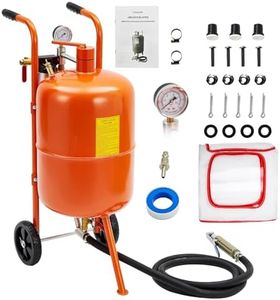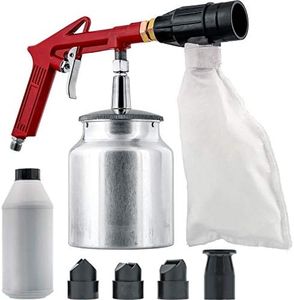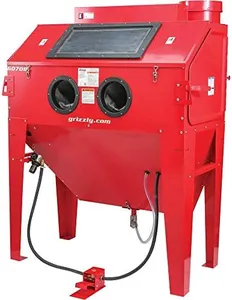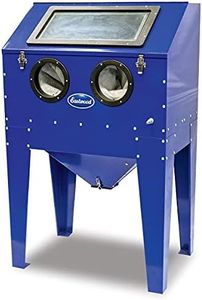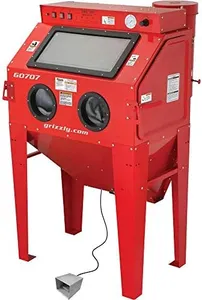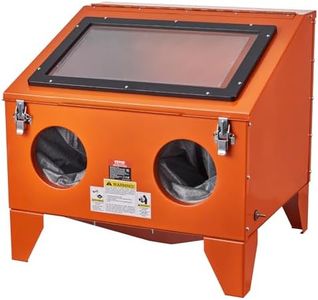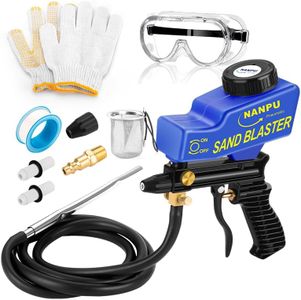10 Best Sand Blasters 2025 in the United States
Our technology thoroughly searches through the online shopping world, reviewing hundreds of sites. We then process and analyze this information, updating in real-time to bring you the latest top-rated products. This way, you always get the best and most current options available.

Our Top Picks
Winner
Eastwood B120 Sand Blasting Cabinet Kit | Heavy Duty Steel Sand Blaster Media Cabinet for Paint Removal, Metal Restoration, Rust Removal, Sandblasting | Holds Up to 150 Lbs of Abrasive Media
Most important from
94 reviews
The Eastwood B120 Sand Blasting Cabinet is designed for users who need a robust and spacious sandblasting solution for tasks like paint removal, metal restoration, and rust stripping. Made from heavy-gauge steel with a powder-coated finish, it promises strong durability and protection against wear. Its size is quite large (over 4 feet wide and 2 feet deep), making it suitable for bigger parts or projects, and it can hold up to 150 pounds of abrasive media, which means less frequent refilling. The cabinet includes convenient features like a large glass lid for easy loading and viewing, side doors for access, and LED lighting to improve visibility while working. A foot pedal for operation helps reduce hand fatigue during longer use, adding to user comfort.
In terms of air requirements, it needs a minimum of 12 CFM at 90 psi, so you’ll need a compatible air compressor that meets these specs to get the best performance. While specific nozzle size and abrasive materials are not detailed, the cabinet's heavy-duty build suggests it supports various common abrasive types. It weighs about 320 pounds and is freestanding, which means it’s not very portable and better suited for a fixed workshop setup rather than mobile use.
Some downsides include its large footprint and weight, making it less ideal for small spaces or frequent relocation. Also, since the product is quite specialized, beginners might need some time to get comfortable with its operation despite the user-friendly design features. The cabinet does not require assembly, which is a plus for quick setup. Eastwood’s reputation and lifetime tech support offer useful peace of mind if you encounter issues or have questions. This sandblaster is best for hobbyists or professionals with medium to large blasting projects who have space for a stable, heavy-duty cabinet and an adequate air supply. It is less suited for casual users needing a compact or portable unit. It provides solid build quality, good capacity, and practical features tailored for effective and controlled sandblasting work.
Most important from
94 reviews
Skat Blast TP Tools USA 2858FP Abrasive Sandblast Sandblasting Cabinet with HEPA Vacuum, 58"W x 28"D x 28"H Work Area, Made in USA
The Skat Blast TP Tools USA 2858FP is a heavy-duty abrasive sandblasting cabinet designed for serious hobbyists or small professional shops that need a large and durable workspace. Its big 58" wide by 28" deep and high work area offers plenty of room for larger parts or multiple smaller items. Made from strong 11 to 18 gauge US steel, the cabinet is built to last and handle abrasive blasting well. It uses air power requiring 10 to 15 cubic feet per minute at 80 psi, which is typical for efficient blasting but means you'll need a reasonably powerful compressor. The included C-35 foot-pedal gun and multiple nozzles (steel and ceramic) give you options for different abrasive materials and blasting precision. The built-in HEPA vacuum is a nice feature to reduce dust, improving visibility and safety during use.
The cabinet includes long double-strength gloves and bright LED floodlights to enhance comfort and visibility while working. One drawback is its large size and 415-pound weight, making it less portable and more suited to a fixed workshop space. Also, while it boasts a 5-year limited warranty and is made in the USA, it ranks modestly in sales compared to other sandblasters, possibly reflecting its niche use. This model is ideal if you want a spacious, well-built cabinet with dust control and reliable components but do not require frequent relocation.
Eastwood B100 Large Abrasive Media Blasting Blast Cabinet with Dust Collector | Internal Dimensions: 45-3/4"W x 22-3/4"D x 22-3/4"H
Most important from
94 reviews
The Eastwood B100 Large Abrasive Media Blasting Cabinet is designed for those in need of a robust solution for sandblasting tasks, particularly in industrial or workshop environments. With its large internal dimensions of 12.1 cubic feet, this sandblaster offers ample workspace, making it ideal for handling larger items or multiple smaller parts simultaneously. The clam shell front opening design allows for easy access, which is a significant advantage when loading and unloading materials.
One of the key strengths of this product is its powerful dust collector, which helps maintain a clean workspace by filtering out abrasive dust. This feature ensures better visibility and safety during use. Additionally, the cabinet's construction from durable steel adds to its longevity, making it a solid investment for serious hobbyists or professionals.
There are some drawbacks to consider. The Eastwood B100 is quite heavy at 319 pounds, which could make it less portable for those who need to move their equipment frequently. It is also a freestanding model, meaning it requires sufficient space in your workshop or garage. Assembly is required upon delivery, which could be a minor inconvenience for some users. The Eastwood B100 is an excellent choice for users looking for a reliable and spacious sandblasting solution, particularly in fixed workshop settings. However, those who value portability or have limited space may want to explore other options.
Most important from
94 reviews
Buying Guide for the Best Sand Blasters
Choosing the right sandblaster can make a significant difference in the efficiency and quality of your work. Sandblasters are used for cleaning, smoothing, or etching surfaces by propelling abrasive materials at high speeds. To find the best sandblaster for your needs, you should consider several key specifications. Understanding these specs will help you make an informed decision and ensure that the sandblaster you choose is well-suited to your specific tasks.FAQ
Most Popular Categories Right Now
